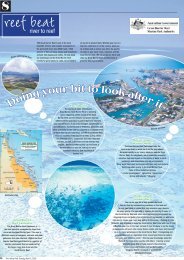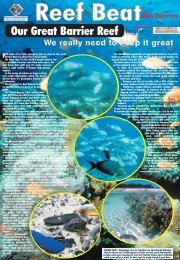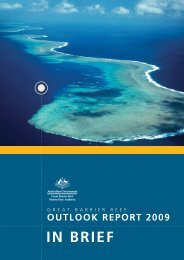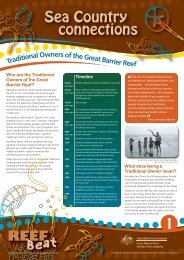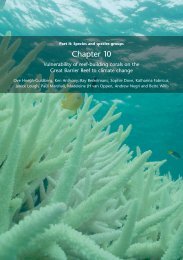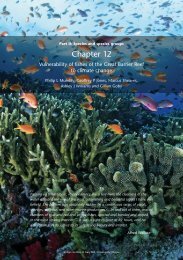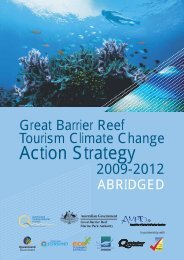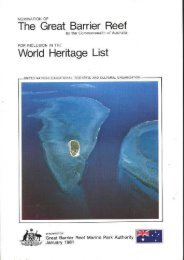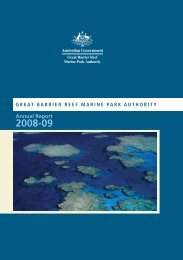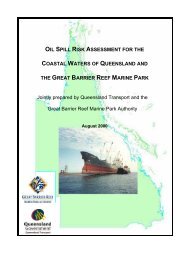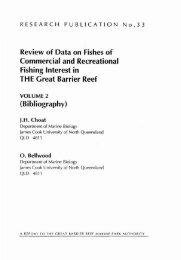Coral Bleaching Response Plan - Great Barrier Reef Marine Park ...
Coral Bleaching Response Plan - Great Barrier Reef Marine Park ...
Coral Bleaching Response Plan - Great Barrier Reef Marine Park ...
Create successful ePaper yourself
Turn your PDF publications into a flip-book with our unique Google optimized e-Paper software.
<strong>Great</strong> <strong>Barrier</strong> <strong>Reef</strong> <strong>Coral</strong> <strong>Bleaching</strong> <strong>Response</strong> <strong>Plan</strong> 2005/2006<br />
(Aerial) helps GBRMPA detect the onset of bleaching and helps assess the full spatial extent and<br />
distribution of a bleaching event.<br />
Objectives:<br />
Strategies:<br />
Triggers:<br />
Assess the spatial extent and distribution of coral bleaching for the entire GBR<br />
Implement a partnership with Coastwatch to incorporate bleaching observations and<br />
photography into routine surveillance flights covering reefs spanning the full length<br />
and breadth of the GBR<br />
Confirmation of conditions conducive to bleaching from the climate and sea<br />
temperature monitoring will trigger the broad-scale synoptic surveys.<br />
3. <strong>Bleaching</strong> Assessment and Monitoring Component<br />
The objective of the <strong>Bleaching</strong> Assessment and Monitoring component is to assess the spatial extent<br />
and severity of coral bleaching events and determine the ecological implications (e.g. coral mortality,<br />
shifts in community structure) resulting from coral bleaching.<br />
Timing is critical for the implementation of bleaching surveys. A bleaching event can progress quite<br />
quickly once visible signs of stress are prevalent, with only four to six weeks required for bleached<br />
corals to either recover or die. On the <strong>Great</strong> <strong>Barrier</strong> <strong>Reef</strong>, the peak of previous bleaching events has<br />
occurred around March-April. If assessments are delayed beyond this time, they are likely to provide an<br />
under-estimate of the amount of bleaching that has occurred as many corals may have died or<br />
recovered, making it difficult to confidently attribute any coral mortality to bleaching-related stress.<br />
A tiered approach using two methods will be used to provide the best possible combination of spatial<br />
coverage and detailed information. The <strong>Bleaching</strong> Assessment and Monitoring component is comprised<br />
of broad-scale synoptic surveys and in-water bleaching surveys. The broad-scale synoptic surveys will<br />
use both MERIS and Quickbird satellite imagery to access different spatial resolution data. CSIRO will<br />
provide the MERIS mapping and the Centre for Remote Sensing and Spatial Information Science at the<br />
University of Queensland will provide the Quickbird high resolution and field mapping. The bleaching<br />
surveys will collect detailed ecological information from a set of established reef sites that represent<br />
cross-shelf as well as latitudinal reefs. This tiered approach is the most effective for obtaining a<br />
synoptic overview of where bleaching is occurring from a GBR-wide perspective.<br />
3.1 Broad-scale synoptic surveys<br />
The correlation between sea surface temperatures and bleaching risk is an area of active research, and<br />
early results are indicating that sea surface temperatures are reliable indicators of regional-scale stress,<br />
but not an accurate predictor of bleaching at individual reefs. Broad-scale synoptic surveys are the most<br />
effective method for obtaining an overview of where bleaching is occurring over spatial scales that are<br />
relevant to management on the GBR (i.e. hundreds to thousands of kilometres). As well as being<br />
important for temporal comparisons of the extent of future bleaching events, broad-scale synoptic<br />
surveys help to identify the reefs or regions worst affected by thermal stress.<br />
The MERIS based mapping will trial a small-scale pilot method during the 2005/2006 summer. The<br />
pilot will involve field validation of remotely sensed images, and will provide a high level of detail on<br />
the health of coral (e.g. healthy coral, bleached coral, recently dead coral). Due to the high level of<br />
resolution, this method will be limited in spatial coverage. The MERIS data will be captured over the<br />
entire GBR and will be used to test the mapping algorithm developed at CSIRO, over inshore and<br />
offshore reefs. The pilot will concentrate in areas around the field survey sites, which will allow the<br />
image data to be validated with field data.<br />
Climate Change <strong>Response</strong> Programme - GBRMPA 6



